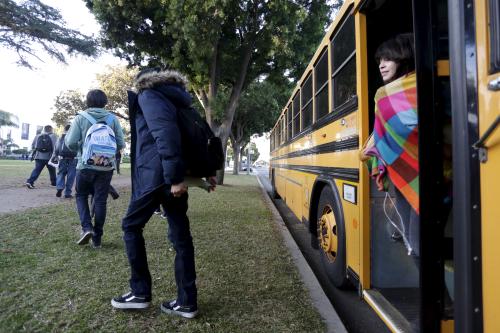Postsecondary education is the entry ticket to the middle class. But for low-income Americans college success is rare. While education has long been seen as a force for social mobility, inclusion, and equity, it is too often the great stratifier in practice.
Boosting social mobility requires interventions that widen the doors to college, and help more students succeed in post-secondary education. There have been a growing number of initiatives, especially “Promise” scholarship programs, aimed at cities and counties to help level the playing field and make a path to a good education available for all.
In “Gown towns: A case study of Say Yes to Education” (PDF), Richard V. Reeves, Katherine Guyot, and Edward Rodrigue explore the experience of one such program—Say Yes to Education, which works at a city level in Syracuse and Buffalo, New York, and a county level in Guilford County, North Carolina.
The authors draw on case studies of the program in Buffalo, Syracuse, and Guilford County and offer four lessons for reformers hoping to expand access to higher education.
1. Collaboration depends on local leadership
Just as individual teachers are hugely important for student learning, individual leaders turn out to be hugely important for the success or failure of their initiatives. This point may seem obvious, even banal. But it is too often forgotten by analysts of reform.
Trust is critical. Leading a collaborative effort requires the leader to be seen by all as independent, rather than acting more on behalf of one on the stakeholders around the table. Trust comes from transparency and communication.
And while the leader should be independent, it is also important—almost necessary—for them to have deep local roots. No matter how well-meaning, an outsider is always an outsider; especially if they are also a temporary resident. Community stakeholders, reasonably enough, want a longer-term, community-wide effort to be led by someone who is sticking around.
2. Collective governance needs a powerful “cabinet” of decision makers
Many initiatives fall victim to the “not made here” problem. Buy-in and ownership at the community level are crucial. This is a leadership, culture, and communication challenge. But it is also a governance question.
While there may be a series of different taskforces, networks, and committees, there needs to be one “cabinet,” a group where big decisions are made. It must be explicit who is wielding the power over these programs.
3. Securing credible commitments is important for sustainability
Education initiatives tend to have a built-in half-life. The rate of turnover in school district leadership, both on the administrative side and on school boards, makes it both harder and more important to build collaborative efforts that will stick, rather than fade away like so many “school reform” efforts.
Part of the secret is ensuring that each local player makes an effective, credible commitment to remain engaged. Various commitment devices can be deployed, in one of three broad categories: contractual (or quasi-contractual), reputational, and financial.
4. Data is the single most important ingredient of reform
Without accurate data, reformers are like lost travelers. Reformers need data to understand the nature of the problem they are trying to address, to see if the problem is being addressed, and to evaluate what works and what doesn’t.
Say Yes’s emphasis on being a data-driven organization is welcome, but the organization has found it’s much easier to talk about data than to collect, share, analyze, and produce it. A common problem facing place-based initiatives is a lack of data availability, at least of sufficient quality and for the specific geographical area.
Making effective use of data is a labor-intensive, long-term undertaking. It cannot be undertaken as a side project, or as an afterthought. It requires hiring experienced data analysts, as well as experts in the creation of technologically sound data platforms. It means starting almost immediately on the onerous task of getting access to administrative datasets so that they can be cleaned and analyzed with sufficient rigor.
Conclusion
There are few tasks as important, and as challenging, as narrowing gaps in educational outcomes. Any attempts to improve educational outcomes for poorer students, or to narrow class gaps in outcomes, are working against the grain. The authors argue that unless accompanied by deeper reform of the education system as a whole, and of the inequality underlying it, even the most ambitious, innovative, and sustained efforts will have, at best, modest results.







